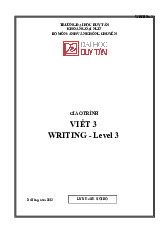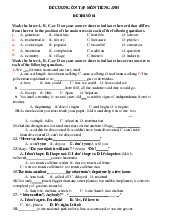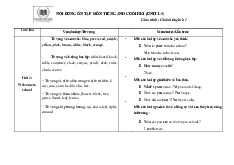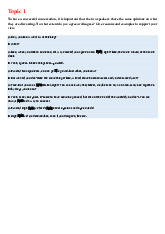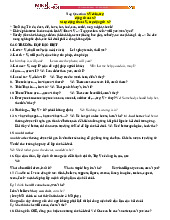












Preview text:
lOMoAR cPSD| 46836766
( Hướng dẫn chấm gồm có 13 trang )
_________________________________________
I. LISTENING (50 points)
Part 1: For question 1-5, listen to the talk about how technology helps archaeologists who want
to learn more about text written known as Roman tablets. Decide whether the following 1 . F 2 . T 3 . T 4 . T 5 . F
statements are True (T) or False (F). Write your answers in the corresponding numbered boxes
on the answer sheet. (10 points)
Part 2: For questions 6-10, you will hear part of the lecture about tea tree oil. Write NO
MORE THAN THREE WORDS taken from the recording. (10 points)) 6. oil extraction
7. coughs, colds (or coughs and colds) 8. constant leg pain 9. paper bark tree(s )
10. powerful antiseptic properties
Part 3: For questions 11-15, you will hear part of a discussion between two environmentalists,
Ken Forbes and Maggie Dimas, who are talking about cars of the future and cyclists. Choose
the answer (A, B, C or D) which fits best according to what you hear and write your answers in
the corresponding numbered boxes on the answer sheet. (10 points) 11 . C 12 . A 13 . C 14 . A 15 . C
Part 4: For questions 16-25, you will hear a talk about SpaceX planning to launch its biggest
rocket ever. Complete the summary with NO MORE THAN FOUR WORDS taken from the
recording. Write your answers in the corresponding numbered boxes on the answer sheet. (20
points) 16 . explosive 17. prototype 18. rocket-grade krosene 19. bell nozzle 20. humongous nozzles 21. drone ship 22. crew and cargo 23. grabbing arm 24. static fire tests 1 lOMoAR cPSD| 46836766 25. glimpse
II. LEXICO - GRAMMAR (30 points)
Part 1. For questions 26-45, choose the best option A, B, C or D to complete each of the following
sentences and write your answers in the corresponding numbered boxes on the
answer sheet. (20 points) 26. D 27. B 28. B 29. D 30. C 31. A 32. B 33. D 34. C 35. C 36. B 37. D 38. A 39. B 40. A 41. C 42. C 43. A 44. B 45. D
Part 2: For questions 46-55, give the correct form of each given word in brackets to complete
the following sentences and write your answers in the corresponding numbered boxes on the
answer sheet. (10 points)
46. ascertain 47. deleterious 48. impressionable 49. malpractices 50. unappreciative 51. infantile 52. unassuming
53. lukewarm 54. luxuriant 55. demystify
III. READING (60 points)
Part 1: For questions 56-65, fill each of the following numbered blanks with ONE suitable word
and write your answers in the corresponding numbered boxes on the answer sheet. (15 points) 56 . Unlike 57 . by 58 . While/ 59 . feeding 60 . never/ Although/ seldom/ rarely Whereas 61 . whose 62 . put . unti 63 l/ before 64 . least 65 . yet 66. A 67. C 68. A 69. A 70. C 71. D 72. D 73. D 74. D 75. C
Part 2: For questions 66-75, read the following passage and choose the best answer A, B, C or
D to each question. Write your answers in the corresponding numbered boxers provided on the
answer sheet. (10 points)
Part 3: For questions 76-88, read the following passage and do the tasks that follow. (13 points) 76. Paragraph A i 77. Paragraph B v 2 lOMoAR cPSD| 46836766 82. F 83. T 84. T 85. F 86. F 87. NG 88. T 78. Paragraph C iii 79. Paragraph D vii 80. Paragraph E vi 81. Paragraph F ix
Part 4. In the passage below, seven paragraphs have been removed. For questions 89-95, read
the passage and choose from the paragraphs A-H the one which fits each gap. There is ONE
extra paragraph which you do not need to use. Write your answers in the corresponding
numbered boxes provided. (7 points) 89 . G 90 . F 91 . D 92 . A 93 . H 94 . E 95 . C
Part 5: The passage below consists of five sections marked A-E. For questions 96-105, read the
passage and answer the questions by choosing from the sections of the article (A-E). The 96 . C 97 . B 98 . E 99 . B 100 . A 101 . C 102 . D 103 . E 104 . E 105 . D
sections may be chosen more than once. Write your answers ( A-E) in the corresponding
numbered boxes provided on the answer sheet. (15 points)
IV. WRITING (60 points)
Part 1: Read the following extract and use your own words to summarise it. Your summary
should be between 100 and 120 words long. (15 points) a) Contents (1.0 pt)
- The summary MUST cover the main points.
- The summary MUST NOT contain personal opinions. - The summary MUST NOT copy exactly
the original text. b) Language use (0.5 pt) The summary:
- should show attempts to convey the main ideas of the original text by means of paraphrasing ( structural and lexical use )
- should demonstrate correct use of grammatical structures, vocabulary, and mechanics (spelling, punctuations, ...) 3 lOMoAR cPSD| 46836766
- should maintain coherence, cohesion, and unity throughout (by means of linkers and transitional devices) SUGGESTED ANSWER:
Robots have the potential to replace doctors and teachers. British education expert Anthony Seldon
predicts that robot will act as teachers in class in the year 2027 by delivering lectures while human
teachers will be like their helpers. However, it is unlikely that robots will ever show their sympathy
and understanding for others nor the ability to interact or communicate. However, a robot teacher
can be superior to a normal teacher in terms of physical and mental endurance. Therefore, the main
focus of education should be how robots can assist teachers with nonteaching work, such as
marking homework and writing reports.
Part 2: The graph below shows the number of overseas visitors to three different areas in a
European country between 1987 and 2007.
Summarise the information by selecting and reporting the main features and make
comparisons where relevant. (15 points) a) Content: (0.6đ)
All the relevant information has been included.
Make general remarks and effective comparisons. b) Organisation: (0.3đ)
The answer flows well and is clear and easy to read, that is, the description is easily understood and well-organised.
c) Use of language: (0.6đ)
Appropriate linking words and phrases as well as a good level of grammar have been used.
Also, the vocabulary is accurately used.
SUGGESTED ANSWER:
The graph illustrates the statistics of international visitors to three different parts of a country
during a 20-year period from 1987 to 2007. Overall, the national tourism industry has experienced
generally positive changes throughout the years with coastal destinations being the most attractive of all.
From 1987 to 1997, the hospitality business in the European country witnessed dramatic
fluctuations. The mountains and the lakes both had some decent growth in the first half of that
decade from 20 thousand to 30 thousand and 10 thousand to 20 thousand respectively. However, 4 lOMoAR cPSD| 46836766
mountainous areas lost their attractiveness and went back to their initial statistics in 1987, while
lacustrine visits continued to increase and doubled in 1997 compared to the first 5 years. The
coasts, though losing some of its visitors at first, had a considerable boost in numbers later that
decade, ending at around 50 thousand in 1997, gaining 25% more guests.
Between 1997 and 2007, the influx of comers kept on and the final results were broadly positive.
Tourists visiting the seaside had the greatest development in this decade with a 50% increase,
while highland tourism also had a small rise of 5 thousand to 35 thousand in 2007. Interestingly,
in 2002, lakeside destinations witnessed a boom in interest, reaching the peak of 75 thousand visits
at its most popular time. Nonetheless, this instant popularity was not sustained and quickly cooled
off, with the number of visitors falling to 50 thousands in 2007.
Part 3: Essay writing (30 points)
Write an essay of (at least 350 words) to express your opinion on the following issue. Some
people prefer to provide help and support directly to those in need. Others, however, prefer to
give money to charitable organizations launched by celebrities.
Discuss both views and give your own opinion.
Give reasons for your answer and include any relevant examples from your own knowledge or experience.
a) Task achievement: (10 points)
a. ALL requirements of the task are sufficiently addressed.
b. Ideas are adequately supported and elaborated with relevant and reliable explanations,
examples, evidence, personal experience, etc.
b) Organization: (10 points)
a. Ideas are well organized and presented with coherence, cohesion, and unity.
b. The essay is well-structured:
• Introduction is presented with clear thesis statement.
• Body paragraphs are written with unity, coherence, and cohesion. Each body
paragraph must have a topic sentence and supporting details and examples when necessary.
• Conclusion summarises the main points and offers personal opinions
(prediction, recommendation, consideration,…) on the issue.
c) Language use: (5 points) 5 lOMoAR cPSD| 46836766
c. Demonstration of a variety of topic-related vocabulary
d. Excellent use and control of grammatical structures
d) Punctuation, spelling, and handwriting (5 points)
a. Correct punctuation and no spelling mistakes b. Legible handwriting THE END - 6 lOMoAR cPSD| 46836766 TAPESCRIPT
Part 1: At the time of the Roman Empire in Europe, around 2,000 years ago, it was common for
information to be written, not on paper, but on things called tablets’. These were pieces of wood
about the size and thickness of a typical modem envelope.
Hundreds of such tablets have been unearthed from archaeological sites throughout Europe and
the Mediterranean world “ nearly 200 were found in one Roman fort alone - and like most of
these discoveries, they have been placed In public collections, mainly in museums In northern
Europe, to be viewed but not, unfortunately, to be read.
This is because, although In some cases traces of writing can still be seen, most are now Illegible
to the naked eye. But that’s all soon to change because archaeologists hope that with the help of
new technology, their secrets may soon be revealed. Many of the tablets took the form of legal
documents and letters written by Roman soldiers. An example, now at the British Museum, bears
the name of the person who wrote it and the name of the person who received it, plus the word
‘transportation’, which you can just make out, but the rest remains a mystery. Now, with the help
of computer techniques, experts hope eventually to be able to read the whole letter. Professor
Mike Brady, a leading figure In what’s known as 'computer vision’ for many years, admits that
this Is the hardest project he’s ever worked on. But the excitement of seeing the latest Ideas In
computing applied to such a very ancient problem has the archaeological community buzzing.
So, In simple terms, why has the writing been preserved and how will it be possible to ‘undo’ the
ageing process? Well, the tablets were made with thin, hollow panels cut across them. Wax was
poured Into these and the text was then written Into this soft surface using an Instrument with a
fine metal point. In virtually all cases, the wax has perished and all that can be detected on the
surface of the tablet underneath are scratches. These are too faint to be read, because they are distorted.
For some time, scientists have attempted to study them with laser photography, but this has
proved fruitless. However, It is now hoped that by enhancing Images of the tablets on computer,
their original messages will become legible again. If this Is the case, a whole new source of
historical Information will be opened up, and this promises advances and new knowledge for
many decades to come. The new technology has already been used on texts In Ink as well, and In
the future, It will be applied to damaged surfaces of many kinds. Part 2: 7 lOMoAR cPSD| 46836766 8 lOMoAR cPSD| 46836766 Part 3: 9 lOMoAR cPSD| 46836766 10 lOMoAR cPSD| 46836766 11 lOMoAR cPSD| 46836766 Part 4:
SpaceX’s operation out of Boca Chica, Texas has been hard at work creating a reusable spacecraft
capable of taking humans to the moon or even Mars. It started with short hops, then test flights
multiple kilometers up with some spectacular landings, both elegant and explosive. Now the
company is preparing to make the next giant leap for their space program: they’re going to send
their latest prototype into orbit for the first time ever.
Sure, SpaceX has launched stuff into orbit before. Lots of stuff, actually. At this point, Falcon 9
launches and landings seem practically routine. But for a number of reasons, Starship is different,
like for example it uses a revolutionary new engine. The Falcon 9 relies on the trusty Merlin
engines, but a big part of the Starship development process has been designing and refining an
engine the company has dubbed Raptor. The Raptor uses liquid oxygen and methane, a departure
from Merlin’s more conventional combination of liquid oxygen and rocket- grade kerosine known
as RP-1. The Raptor also uses what’s known as a full-flow staged combustion system which uses
every bit of fuel for thrust unlike Merlin’s open-cycle system. These changes are designed to make
Starship’s engines more powerful, efficient, and reusable, all desirable traits for engines that could
one day ferry people to and from other worlds. To date, Starship prototypes have had at most three
raptor engines, but SN 20 will have six. The additional three aren’t for getting the craft into orbit,
but don’t you worry we’ll get to that. No, the other three raptors are optimized to work better in 12 lOMoAR cPSD| 46836766
the vacuum of space. The most obvious difference between them and the sea-level optimized
raptors is the addition of a giant bell nozzle that improves efficiency in space. So then, how is
SN20 going to get into orbit if it only has just the three sea level optimized engines plus the added
weight of hauling three more engines and their humongous nozzles up there. The solution is to
carry Starship up with a booster rocket called the Super Heavy, which will sport 29 raptor engines.
This will be the first time ever this massive booster stage has flown. SpaceX briefly stacked one
stage on top of the other back in August. It was only to check the fit but at 120 meters tall, it
became the tallest rocket ever assembled. One of the major advances SpaceX made to rocket
science is landing the first stage of their rockets safely back on the ground. Falcon 9 boosters gently
touching down on drone ships not only look straight out of science fiction, but have allowed the
company to reuse their rockets over and over. Their goal is to master the same trick with Starship,
and they’ve been fine-tuning just how to
bring it back down gently. If Starship is ever going to land on other planets like Mars, they’ll have
to get it down perfectly if they don’t want to flatten the crew or cargo.
Reusability will also drive down the cost of launches, so SpaceX would like to make both stages
of the launch capable of soft landing, although the proposed design for the Super Heavy involves
a tower with grabbing arms that would literally catch it as it slowly descended toward earth. For
SN 20 and its Super Heavy, gentle touchdowns aren’t part of the plan. Its launch is solely focused
on getting Starship into orbit, and once it gets there, who cares how it comes down right now? The
Super Heavy is expected to hit the water in the gulf of Mexico, while, fingers crossed, Starship
reaches orbit before coming down again near Hawaii. SN20 has had a few static fire tests to make
sure both the vacuum and sea level raptors are functioning. If the Super heavy boosts Starship into
orbit successfully, then SpaceX’s plans will really start taking shape. They’ll have to perfectly land
each stage of the rocket and probably figure out a million other things, but still the outcome of this
upcoming starship launch could give us a very clear glimpse of what is to come. 13
